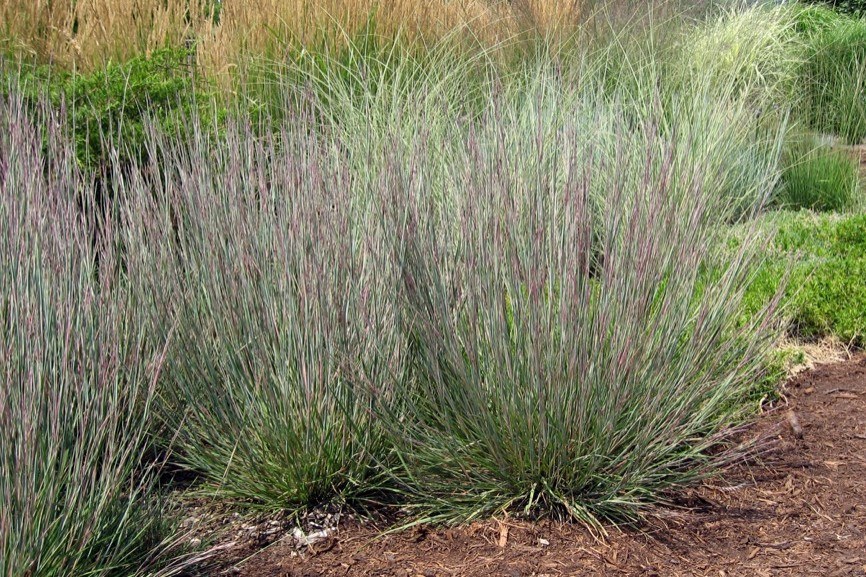Posted: February 17, 2022
the Perennial Plant Association has made the selection of reliable and beautiful perennials much easier by launching The Perennial Plant of the Year™ program.

Little Bluestem Grasses. Photo credit: Perennial Plant of the Year ASSN
Now is a good time of year when gardeners are planning what new and exciting plants to try. If you have trouble selecting the right perennial plant for the right spot so that it survives to return again and again, you are not alone. Proper site and plant selection are the toughest criteria to get right for amateur gardeners and even Master Gardeners and Garden Club members. I can attest to the latter two definitely being accurate because they both apply to me.
However, there is an organization, the Perennial Plant Association, which, starting in 1990 made the selection of reliable and beautiful perennials much easier by launching The Perennial Plant of the Year™ program. Remember that perennial plants grow, bloom, set seed, and die back over winter to return in the spring unlike annuals. Annuals bloom, set seed, and do not return as the original plant, but potentially as self-sown seedlings or not at all.
The purpose of The Perennial Plant of the Year™ program is to showcase a single perennial plant that stands out among other similar rivals. Perennials chosen have the best attributes that lead to their selection as The Perennial Plant of the Year™. They are suitable for a wide range of growing climates, are low maintenance, are interesting for more than one season, and are fairly disease-free. Gardeners can be relatively assured that these chosen plants will succeed given proper care.
Members of the Perennial Plant Association choose one perennial each year. In addition to voting, members submit nominations for future consideration. Some 400 plus plants can be nominated in a single year. The Perennial Plant of the Year™ committee reviews the nominations and selects three or four perennials to be placed on the ballot.
Nominations need to meet these criteria:
- Suitable for a wide range of climatic conditions.
- Low-maintenance.
- Relative pest-free and disease-resistant.
- Readily available in the year of promotion.
- Multiple seasons of interest.
The listing of plants chosen since the beginning of this process shows a diversity of plants suited to a variety of garden interests. Complete horticultural information on each can be found at the Perennial Plant Association website. The list is in year order starting with 1990 and ending with 2022.
Phlox stolonifera - Purple flowered phlox
Heuchera micrantha 'Palace Purple' - Dark purple/green leaves
Coreopsis verticillata 'Moonbeam' - Solid yellow flowers with yellow centers
Veronica 'Sunny Border Blue' - Tall blue narrow spires of flowers
Astilbe 'Sprite' - Fernlike foliage with pink feathery spires
Perovskia atriplicifolia Russian Sage - Small shrub with tall lacey purple floral spires
Penstemon digitalis 'Husker Red' - Red stems, pale flowers, burgundy foliage
Salvia 'Mainacht' May Night - Purple floral spires on broader green leaved stems
Echinacea purpurea 'Magnus' - Deep fuscha colored coneflower
Rudbeckia fulgida var. sullivantiii 'Goldsturm'- Black-eyed Susan
Scabiosa columbaria 'Butterfly Blue' - Round very blue circular flowers
Calamagrostis x acutiflora 'Karl Foerster' - Ornamental grass
Phlox 'David' - White flowers
Leucanthemum 'Becky' Daisy - White daisy with yellow center
Anthyrium niponicum ' Pictum' - Red stemmed fern with green and white fronds stripe
Heleborus x hybrids - Many-colored Hellebore hybrids.
Dianthus gratianopolitanus 'Feuerhexe' - Fusha flowers
Nepeta 'Walkers Low' - Mounding small leaf habit with lavender flowers
Geranium 'Rozanne' - Blue-purple flowers
Hakonechioa macra 'aureola' - Ornamental grass
Baptisia australis - Vibrant blue flowers leading to interesting black seed pods
Amsonia hubrichtii - White star like flowers on taller stems
Brunnera 'Jack Frost' - Variegated blue Forget Me Not-like flowers with green and white leaves
Polygonatum odoratum 'Variegatum' - Solomans Seal foliage with white edged leaves
Panicum virgatum 'Northwind' - Tall Switch Grass
Geranium 'Biokoyo' - Dwarf Cranesbill Geranium (hardy)
Anemone x hybrid 'Honorine Jobert' - White Japanese anemone
Asclepias tuberosa - Butterfly Weed with orangey flowers
Allium 'Millenium' - lavender flowers
Stachys 'Hummelo' - pink flowers
Aralia cordata - Sun King with lime foliage
Calamintha nepeta - Catmint with purple flowers
The 2022 Perennial Plant of the Year® is Little Bluestem, Schizachyrium scoparium and its cultivars.
Little bluestem grasses are a changing mix of gray-green, blue, pink, purple, copper, mahogany, red, and orange tones. Silver-white seed heads show off in fall sun and copper-brown leaves persist through winter. Native to a broad part of North America, it once was one of the dominant grasses of the tall-grass prairies.
Little bluestem is a tough and dependable clumping grass. It blends well with other perennials such as aster, sedum, coneflower, and other grasses. It acts as a pollinator grass for the larvae of a variety of butterflies and moths, including various skippers.
In average well-drained soils, stems tend to stay upright but can flop if conditions are too rich a soil or persistently too moist. Some cultivars have shorter plants, enhanced leaf colors, and stronger stems. Little bluestem's spikiness goes well with other perennials in the garden. It works for mass plantings or in meadows plus traditional borders. Companion plantings are recent Perennial Plants of the Year ® such as catmint, Calamintha nepeta, Butterfly Weed (Plant) Asclepias tuberosa, Stachys 'Hummelo', and Allium millenium.
Connie Holland is a Penn State Master Gardener from Adams County. The Penn State Cooperative Extension of Adams County is located at 670 Old Harrisburg Road, Suite 204, Gettysburg, phone 334-6271.

